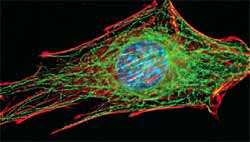"Booster rocket" malfunction implicated in Huntington ’s disease

Neuronal cell showing the cells “skeleton” : actin micro filaments in red and micro-tubules <br>network in green.
CNRS and Inserm research scientists at the Institut Curie have shed new light on the function of huntingtin, the protein whose mutation underlies Huntington ’s disease. This neurodegenerative disease,like Alzheimer ’s or Parkinson ’s,is characterized by the abnormal death of certain neurons.
The scientists have discovered that huntingtin,like a “booster rocket “,accelerates the transport of a neuron survival factor. When huntingtin is mutated, the “booster rocket ” malfunctions, transport slows, protection wanes, and neurons die.
This discovery, published in the 9 July 2004 issue of Cell, could in time lead to novel therapeutic methods of blocking the accelerated death of neurons.
Huntington ’s disease is a genetic disorder which affects some 6 000 people in France and concerns over 12 000 carriers of the mutated gene who for the time being are free of clinical signs. It is characterized by uncontrollable movements, personality changes, dementia and death 10 to 20 years after onset of the first symptoms.
The gene responsible for this disease has been identified. It codes for the protein huntingtin, whose function until now has been poorly understood. One thing is sure, huntingtin protects neurons against cell death. But when it is mutated, the reverse happens: by a mechanism as yet unelucidated, the mutation in huntingtin leads to accelerated death of neurons in the striatum, the brain region where Huntington ’s disease arises.
Huntingtin: a “booster rocket”
To understand how huntingtin controls neuronal survival, Laurent Gauthier and Bénédicte Charrin, directed by Sandrine Humbert 1 and Frédéric Saudou 2 at the Institut Curie, used 3D videomicroscopy to observe the effect of huntingtin.
In its normal state, huntingtin “boosts” the transport of BDNF 3, which is needed for survival of neurons in the striatum. BDNF “manufactured “in the cortex is thus transported to the striatum:
- along microtubules acting as “rails”: these long specialized filaments are uniformly distributed in cells and transport molecules to their destinations;
- by molecular motors acting as “locomotives”: these motor proteins harness the energy of ATP to “run”along the microtubular “rails ”in one direction with proteins in tow.
When apoptosis goes wrong…
In all organisms, cells develop, reproduce, and die. But cell death occurs in more than one way: accidentally – this is necrosis – or “by choice”– this is apoptosis. This programmed death eliminates excess cells or gets rid of damaged and thus potentially harmful cells.The least anomaly in apoptosis can lead to fateful dysfunction. Numerous diseases bear witness to this:
- when apoptosis is blocked,damaged cells are no longer eliminated and there is then a risk of cancer
- likewise, accelerated apoptosis results in abnormal loss of neurons which gives rise to certain neurodegenerative diseases like Alzheimer ’s disease, Parkinson’s disease or Huntington’s disease.
The research team has shown that when huntingtin is normal BDNF is transported to the striatal neurons at high speed, but when huntingtin is altered transport slows greatly. In the long term, this slowing of BDNF trafficking compromises survival of striatal neurons.
This slowdown could also explain the late onset of Huntington’s disease. In the early years, BDNF continues to reach the neurons of the striatum, albeit more slowly, and blocks the apoptotic effect of mutant huntingtin. BDNF levels then gradually decrease in the striatal neurons – perhaps due to the effect of other factors – and the apoptosis induced by mutant huntingtin can no longer be “thwarted”. It is known, moreover, that there is less BDNF in the striatal neurons of Huntington’s disease patients.
Although still at the research stage, this work opens up new investigational pathways in the treatment of Huntington’s disease. If we could “accelerate” the transport of BDNF to the striatal neurons, we may be able to “deactivate” apoptosis by blocking the effect of mutant huntingtin. In the longer term, other diseases, like cancer, in which apoptosis plays a fundamental role, could also benefit from these discoveries.
Reference
“Huntingtin controls neurotrophic support and survival of neurons by enhancing BDNF vesicular transport along microtubules” Laurent R.Gauthier1, Bénédicte C.Charrin1, Maria Borrell-Pagès1, Jim P.Dompierre1, Hélène Rangone1, Fabrice P.Cordelières1, Jan De Mey1, Marcy E.MacDonald2, Volkmar Leßmann3, Sandrine Humbert1, Frédéric Saudou1
Cell,9 July 2004
1UMR 146 CNRS/Institut Curie,Paris,France
2Molecular Neurogenetics Unit,Massachusetts General Hospital,Charlestown,Massachusetts,USA
3 Institut für Physiologie &Pathophysiologie,Johannes Gutenberg-Universität Mainz,Germany
Media Contact
More Information:
http://www.curie.frAll latest news from the category: Life Sciences and Chemistry
Articles and reports from the Life Sciences and chemistry area deal with applied and basic research into modern biology, chemistry and human medicine.
Valuable information can be found on a range of life sciences fields including bacteriology, biochemistry, bionics, bioinformatics, biophysics, biotechnology, genetics, geobotany, human biology, marine biology, microbiology, molecular biology, cellular biology, zoology, bioinorganic chemistry, microchemistry and environmental chemistry.
Newest articles

First-of-its-kind study uses remote sensing to monitor plastic debris in rivers and lakes
Remote sensing creates a cost-effective solution to monitoring plastic pollution. A first-of-its-kind study from researchers at the University of Minnesota Twin Cities shows how remote sensing can help monitor and…

Laser-based artificial neuron mimics nerve cell functions at lightning speed
With a processing speed a billion times faster than nature, chip-based laser neuron could help advance AI tasks such as pattern recognition and sequence prediction. Researchers have developed a laser-based…

Optimising the processing of plastic waste
Just one look in the yellow bin reveals a colourful jumble of different types of plastic. However, the purer and more uniform plastic waste is, the easier it is to…



